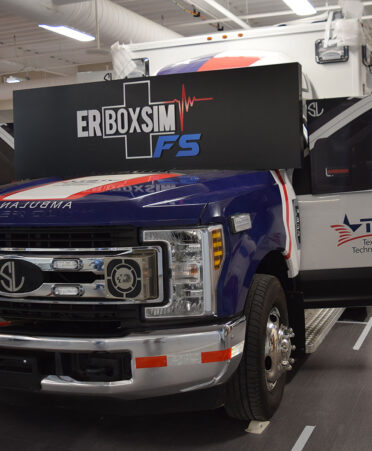(ABILENE, Texas) – Training to save lives requires dedication by both students and instructors.
At Texas State Technical College, the Emergency Medical Services program has taken training students to a new level with the introduction of the first complete ambulance simulator in North America.
In June, Echo Healthcare delivered to TSTC’s Abilene campus a Ford F350 ambulance that was converted from a road-operating vehicle to a full-size simulator.
Coby Meyer, Echo Healthcare’s chief operating officer, and others from the Florida-based company worked with Ronnie Pitts, director of decision support of TSTC’s Allied Health division, to design the simulator.
“TSTC is a pinnacle partnership for us,” Meyer said. “This started out as a simple conversation. When it comes to technology, TSTC is the trend leader. Ronnie and his team came to us and simply asked if we could do this scope of a project. There was not going to be an obstacle standing in our way.”
Pitts wanted to have a full-size ambulance for TSTC’s EMS students to train with at the Abilene campus. Echo Healthcare began the conversion by removing the ambulance simulator’s engine and replacing it with SimLeader technology under the hood. The windshield and side windows of the cab are now equipped with large video monitors that will give trainees the feeling of actually traveling on various roadways in West Texas.
“Cutting-edge technology in EMS education accomplishes much more than providing an efficient, safe and realistic opportunity for students to learn,” Pitts said. “TSTC creates learning environments that inspire students to embrace innovation, adapt to technological advancements, and actively contribute to the rapidly evolving world. We are preparing them to be future leaders, problem-solvers and contributors in a technology-driven society in as lifelike a simulation as possible.”
For ambulance companies, the simulator will help future employees in many ways. Will Hendon, the North Texas regional director of Global Medical Response, said it will save his company time spent in training employees.
“We send our EMTs to a two- to three-day course for them to learn how to drive an ambulance,” said Hendon, a 2010 TSTC EMS graduate. “Imagine driving a smaller car your entire life. Getting into the driver’s seat of an ambulance will feel overwhelming. It brakes differently than a regular vehicle, and it accelerates differently. This is going to help ambulance companies in that respect the most.”
Kyle Nichols, a current Paramedic student at TSTC, sees another benefit of the simulator.
“To have someone actually in the driver’s seat so we will be able to communicate time and distance from the hospital will be vital to our training,” he said. “Our entire career is built around good communication.”
The ambulance will be used during training sessions by students to play out different scenarios. Students will begin by responding to a medical scene in TSTC’s Immersive Interactive lab. The scene, displayed on three walls and the floor in a different classroom, could range from a city park to a family home.
Students will arrive on the scene to find a medical manikin in the scene. They will assess the patient and begin the transport process from the scene to the ambulance. Once loaded into the ambulance, one student will be in the back treating the patient while the other will be driving.
Instructors will be able to see what is happening through video monitors, allowing them to change road conditions through the installed computer programming. Those road conditions could include skidding on ice or hitting a pothole, which will actually give those inside the feeling that they are sliding or bouncing.
Once the students arrive at the virtual hospital, the patient will be transported back to the Immersive Interactive lab, which will be reset into a virtual emergency room.
“There will be a lot of moving parts to this technology,” Hendon said. “TSTC is taking the training to the next level. We have not seen this type of impact on the EMS industry before.”
According to onetonline.org, the need for paramedics in Texas was expected to grow 19% between 2020 and 2030. The annual average salary for paramedics in Texas is $48,380.
In its Emergency Medical Services program, TSTC offers an Associate of Applied Science degree in Paramedic, as well as certificates of completion in Emergency Medical Services – EMT, Emergency Medical Services – Advanced EMT AEMT and Emergency Medical Services – Paramedic. The program is available at the Abilene, Brownwood and Harlingen campuses.
According to Echo Healthcare’s website, www.echo.healthcare, SimLeader technology provides a safe training environment that allows teams to prepare for the unpredictable and properly evaluate their limitations and capacities under stress.
For more information about TSTC, visit tstc.edu.
